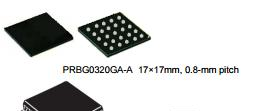基于FLOW90系列和R7S910001CFP 32位MCU的中小功率书本式伺服系统解决方案
 343
343
 拍明
拍明
方案概述
随着目前智能设备和机器人的发展,伺服系统的应用也越来越广泛。我们对指标功能要求更加多样化,不同的应用对结构也有不同的需求。本文为迎合中小功率的书本式架构的伺服系统提供了高指标、结构紧凑、可提高设备散热能力的解决方案。
器件优势
• 中小功率书本式IGBT模块(FLOW90系列),使约1000-5000W功率的伺服系统的主板和散热器间成90度,呈书架式架构,易通风散热且小型化;
• 具有R4F内核的32位MCU(R7S910001CFP),最高600MHz主频,内部集成工业以太网Ether CAT控制器、编码器接口(可支持多种协议的编码器)、单相和三相伺服逆变控制功能。
【R7S910001CFP】
300 MHz/450 MHz/600 MHz, MCU with ARM Cortex®-R4 and -M3*1, on-chip FPU, 498/747/996DMIPS, up to 1 Mbyte of on-chip extended SRAM, Ethernet MAC, EtherCAT*1, USB 2.0 high-speed,CAN, various communications interfaces such as an SPI multi-I/O bus controller, ΔΣ interface, safetyfunctions, encoder interfaces*1, and security functions*1

Features
■ On-chip 32-bit ARM Cortex-R4 processor
• High-speed realtime control with maximum operating frequency of300/450/600 MHzCapable of 498/747/996 DMIPS (in operation at 300/450/600MHz)
• On-chip 32-bit ARM Cortex-R4 (revision r1p4)
• Tightly coupled memory (TCM) with ECC: 512 Kbytes/32 Kbytes
• Instruction cache/data cache with ECC: 8 Kbytes per cache • High-speed interrupt
• The FPU supports addition, subtraction, multiplication, division,
multiply-and-accumulate, and square-root operations at singleprecision
and double-precision.
• Harvard architecture with 8-stage pipeline
• Supports the memory protection unit (MPU)
• ARM CoreSight architecture, includes support for debugging
through JTAG and SWD interfaces
■ On-chip 32-bit ARM Cortex-M3 processor
(in products incorporating an R-IN engine)
• 150-MHz operating frequency • On-chip 32-bit ARM Cortex-M3 (revision r2p1) • RISC Harvard architecture with 3-stage pipeline • Supports the memory protection unit (MPU)
■ Low power consumption
• Standby mode, sleep mode, and module stop function
■ On-chip extended SRAM
• Up to 1 Mbyte of the on-chip extended SRAM with ECC
• 150 MHz
■ Data transfer
• DMAC: 16 channels × 2 units
• DMAC for the Ethernet controller: 1 channel
■ Event link controller
• Module operations can be started by event signals rather than byinterrupt handlers.
• Linked operation of modules is available even while the CPU is in
the sleep state.
■ Reset and power supply voltage control
• Four reset sources including a pin reset
• Dual power-voltage configuration: 3.3 V (I/O unit), 1.2 V(internal)
■ Clock functions
• External clock/oscillator input frequency: 25 MHz
• CPU clock frequency: Up to 300/450/600 MHz
• Low-speed on-chip oscillator (LOCO): 240 kHz
■ Independent watchdog timer
• Operated by a clock signal obtained by frequency-dividing theclock signal from the low-speed on-chip oscillator: Up to 120 kHz
■ Safety functions
• Register write protection, input clock oscillation stop detection,CRC, IWDTa, and A/D self-diagnosis
• An error control module is incorporated to generate a pin signaloutput, interrupt, or internal reset in response to errors originatingin the various modules.
■ Security functions (optional)*2
• Boot mode with security through encryption
■ Encoder interfaces (optional)*3
• EnDat 2.2, BiSS-C, FA-CODER, A-format, and HIPERFACEDSL-compliant interfaces*4
• Frequency-divided output from an encoder
■ Various communications interfaces • Ethernet
- EtherCAT slave controller: 2 ports (optional) - Ethernet MAC: 1 port (an Ethernet switch is not used) or
- Ethernet MAC: 1 port (an Ethernet switch to support 2 ports is used) • USB 2.0 high-speed host/function : 1 channel • CAN (compliant with ISO11898-1): 2 channels (max.) • SCIFA with 16-byte transmission and reception FIFOs: 5 channels
• I2C bus interface: 2 channels for transfer at up to 400 kbps
• RSPIa: 4 channels
• SPIBSC: Provides a single interface for multi-I/O compatibleserial flash memory
■ External address space
• Buses for high-speed data transfer at 75 MHz (max.) • Support for up to 6 CS areas • 8-, 16-, or 32-bit bus space is selectable per area
■ Up to 33 extended-function timers
• 16-bit TPUa (12 channels), MTU3a (9 channels), GPTa (4channels): Input capture, output compare, PWM waveform output
• 16-bit CMT (6 channels), 32-bit CMTW (2 channels)
■ Serial sound interface (1 channel)
■ ΔΣ interface
• Up to 4 ΔΣ modulators are connectable externally.
■ 12-bit A/D converters
• 12 bits × 2 units (max.)(8 channels for unit 0; 16 channels for unit 1)
• Self diagnosis
• Detection of analog input disconnection
■ Temperature sensor for measuring temperature within the chip
■ General-purpose I/O ports
• 5-V tolerance, open drain, input pull-up
■ Multi-function pin controller
• The locations of input/output functions for peripheral modules areselectable from among multiple pins.
■ Operating temperature range
• Tj = -40°C to +125°C
Tj: Junction temperature

简单的系统主要由驱动器和伺服电机以及上位PLC组成。复杂的需要加上运动控制器,用于协调多轴之间的运动关系。
1,驱动器根据不同的工艺以及所需求的过载能力来选择功率及附件,如总线卡和制动电阻等,当然不同的驱动器可能有针对不同行业的程序工艺包。
2,伺服电机有同步伺服和异步伺服,由电机本身和编码器组成,而编码器又分为增量和绝对值两种,用于反馈速度和位置,有的机械结构可能容易产生相对滑动,会额外增加外部的编码器,比如光栅尺,用于位置环。
3,PLC主要用于处理逻辑,针对伺服控制器来说一般输出有IO信号,模拟量以及总线控制字等。
4,运动控制器主要处理多轴之间的关系,对于有严格位置关系的工艺来说是必不可少的。
责任编辑:Davia
【免责声明】
1、本文内容、数据、图表等来源于网络引用或其他公开资料,版权归属原作者、原发表出处。若版权所有方对本文的引用持有异议,请联系拍明芯城(marketing@iczoom.com),本方将及时处理。
2、本文的引用仅供读者交流学习使用,不涉及商业目的。
3、本文内容仅代表作者观点,拍明芯城不对内容的准确性、可靠性或完整性提供明示或暗示的保证。读者阅读本文后做出的决定或行为,是基于自主意愿和独立判断做出的,请读者明确相关结果。
4、如需转载本方拥有版权的文章,请联系拍明芯城(marketing@iczoom.com)注明“转载原因”。未经允许私自转载拍明芯城将保留追究其法律责任的权利。
拍明芯城拥有对此声明的最终解释权。




 产品分类
产品分类















 2012- 2022 拍明芯城ICZOOM.com 版权所有 客服热线:400-693-8369 (9:00-18:00)
2012- 2022 拍明芯城ICZOOM.com 版权所有 客服热线:400-693-8369 (9:00-18:00)


